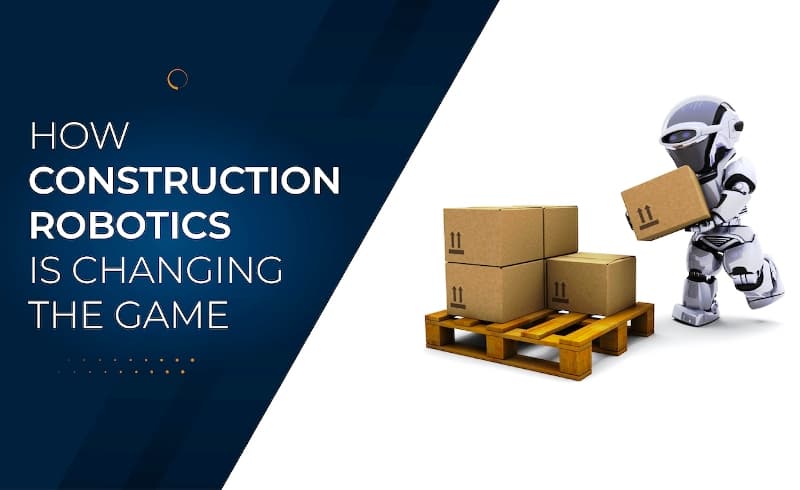
Construction is a sector primarily reliant on human resources. The construction industry is lagging considerably in adopting digital technologies, robotics, and automation since it is one of the least automated.
Robots for the construction industry have a lot to offer regarding automation, as they can streamline many processes using construction robotics. Using robots rather than humans in the building is still a concern for some people. Due to a lack of qualified workers and a low unemployment rate in some countries, robotics and automation are essential if the country is to satisfy demand and continue growing economically. As prototypes and early applications of robotics in the construction industry continue to emerge, robots will play an increasingly important role in buildings as researchers, academia, and technology businesses continue to push the boundaries.
Uses of Robotics in the Construction Industry

Robotic technology is already impacting the construction sector and will continue to do so in the future. Robotics for construction is used in the following ways, for example:
- Brick-Laying
- 3D Printing
- Self-Driven Vehicles
- Demolition
- Exoskeleton
Let’s look more closely at the use of automation and robotics in construction.
1. Brick-Laying

Automation and robotics in construction use data from 3D CAD models to build walls and block structures. In this way, there will be less waste of materials and a reduction in building costs, in addition to making the process faster and more efficient. Hadrian X is one such example of a robot for the construction industry.
2. 3D Printing

Specialized 3D printers are used for 3D printing in the construction industry. Programming and artificial intelligence control, such as 3D printers used in construction. The high-tech construction robots read the CAD models and 3D print the building using layers of materials with great precision, like bricklaying. The example of a 3D-printed bridge in Amsterdam is undeniably impressive.
3. Self-Driven Vehicles

The construction industry’s working methods have been revolutionised by the introduction of automation and robotics in the construction or self-driving vehicles. Autonomous robots in construction allow for more rapid completion of tasks while maintaining the highest levels of safety and efficiency possible. It reduces the manual labour required to execute the given task to a certain extent. In terms of security, the fact that this type of equipment may function autonomously in landscapes or hazardous environments is a benefit.
4. Demolition

Demolition robots could be a viable alternative to specialised demolition crews on construction sites. These robots can operate from a safe distance, ensuring the safety of construction employees. The automation of the demolition process also contributes to faster project completion.
5. Exoskeleton

Musculoskeletal problems and work-related injuries continue to be significant issues in the construction industry. Exoskeletons are an emerging type of wearable technology that can help or improve a user’s physical ability, say Sunwook Kim, et al.(authors of the journal article – Potential of Exoskeleton Technologies to Enhance Safety, Health, and Performance in Construction: Industry Perspectives and Future Research Directions).For a construction worker, an exoskeleton is a lifesaver. People can wear this metal framework as a brace for safety. These can help reduce construction site accidents while allowing workers to complete their tasks more quickly and effectively. When handling heavy tools, exoskeletons help enormously by stabilising the weight and providing excellent balance.
Benefits of Robotics in Construction
Construction robotics offers numerous benefits, some of which are:
- Automating building sites with robots and other forms of automation and robotics in construction provides workers with greater protection from harm.
- Another benefit of robotics in construction is that the automated system requires fewer operators, which reduces difficulties with the quality and repetitiveness of work.
- The initial purchase price may remain high, but the efficiency and precision advantages will make up for the price difference over time.
- Robotics in the construction industry provides a unique chance to attract many highly skilled graduates. This is critical for construction, which has a hard time attracting younger workers.
- It is easier to identify faults due to close monitoring of each step of the process. It ensures that the system is working properly and that the results of each one is accurate.
- Construction robotics can expedite the repair process for infrastructure failures such as dam or bridge collapses, which may result in injuries or even the loss of lives.
Disadvantages of Robotics in Construction
Like advantages, construction robotics has to go a long way through hurdles. Some disadvantages of robotics in construction include:
- A lot of development has to happen before bringing cutting-edge technologies into the workplace. This includes ownership, planning, skilled hiring, capital, etc.
- Contractors will have to pay for the installation and fine-tuning of these systems to see the benefits.
- Workers fear losing their jobs, and robotics and automation have begun to replace a significant portion of the construction industry’s workforce, eliminating the need for human procedures.
- Robotics for construction, like any other technological advancement, will require periodic upkeep to remain effective. It may sound simple, but the costs of maintaining multiple robots can quickly add up.
- Another issue that could slow down mechanical construction is cyber security. The hacker can get access to the mainframe, disrupting construction planning and leading to greater capital losses.
Future of Robotics in Construction

Conventional building techniques are being replaced by cutting-edge technology such as the Internet of Things (IoT), robotics, and automation. Robotics for construction produces precise outcomes in a shorter period of time, at a lower cost, and with less resource waste. We could eventually have a construction site where a single operator controls up to ten pieces of equipment at once, allowing projects to run 24 hours a day, seven days a week, because of advanced construction robotics. Due to advances in technology, a task that once took months to complete, now takes only a few weeks.
Demand for residential and non-residential development spaces is also increasing as more people want to live and work in urban areas. As a result, the need for robotics in the construction industry is on the rise. Drones can now collect data, foresee problems, and fix them before they occur, which benefits people looking for homes. Humans working from a distance will be in charge of several initiatives. The focus of the industry will now be on new product creation. The future of robotics in construction will be more efficient thanks to 3D and 4D printing, as well as things that self-transform and assemble.
Conclusion
Construction robotics has many advantages that have caused a revolution in the business. There are fewer and fewer obstacles to the automation of building operations, and robots are imprinting themselves on the industry. Robotics in the construction industry has a promising future and will fundamentally alter existing civil engineering techniques and methods.
Image Courtesy: Image 7
Author Bio
Nafisa Nazneen Choudhury – Nafisa Nazneen Choudhury is a Civil Engineer (completed B.E. from Assam Engineering College) and is currently pursuing M.Tech in Structural Engineering at National Institute of Technology, Silchar. She is a Technical Content Writer, having over 3 years of experience and has wrote many articles related to Civil Engineering. She is also a Book Author (Authored – “Dream Tales of NNC: Revenge By Murder”) and her book can be found on Amazon. She is also a Guest Author at Gharpedia. Moreover, she is a certified member at Institution of Civil Engineers (ICE) and National Society of Professional Engineers (NSPE). She writes her blogs at her website – nnc2017.wordpress.com. She can be reached on LinkedIn.






























